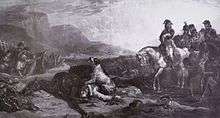Charles George Lewis
Charles George Lewis (13 June 1808 – 16 June 1880) was a British printmaker.
Life
The second son of Frederick Christian Lewis, and brother of John Frederick Lewis, he was born in Enfield, Middlesex. He was instructed in drawing and engraving by his father.[1]
Lewis retired in about 1877, and died suddenly from apoplexy at his residence at Felpham, near Bognor, on 16 June 1880. He was buried in Felpham churchyard.[1]
Works
Lewis had a facility in etching, and in combining line engraving, stipple, and mezzotint.[1]
Many of his best-known plates were after the works of Sir Edwin Landseer. The earliest of these was Hafed, published in 1837.[2] Besides these were smaller plates after works of Landseer, most of which had previously been engraved by Thomas Landseer and others.[3] His etchings after Landseer began with To-ho! published in 1830, and included the set of eight plates of The Mothers.[1]
Lewis engraved also some plates after Rosa Bonheur.[4] His works after other painters included:[1]

- Interior of a Highland Cottage, after John Frederick Lewis
- Robinson Crusoe reading the Bible to his Man Friday and Asking a Blessing, after Alexander George Fraser
- The Village Festival and The Card Players, after Sir David Wilkie
- The Bay of Spezzia, Sea-shore, and Sunset, after Richard Parkes Bonington
- The Highland Larder, after Frederick Tayler
- The Waterloo Heroes, after John Prescott Knight
- The Melton Breakfast, after Sir Francis Grant
- The Introduction of Christianity into Great Britain, after John Rogers Herbert
- Eton Montem: the School Yard and The Playing Fields, a pair, after William Evans of Eton
- Sheep Farming in the Highlands, a set of four plates, and Rescued, after Richard Ansdell
- A Plunge for Life, after Samuel Carter
- The Crucifixion, after Henry Courtney Selous
- Morning on the Seine, after J. Troyon
- The Salon d'Or, after William Powell Frith
- A Panic, after Henry William Banks Davis
- Picardy Peasants going to a Fair, after Richard Beavis
and several historical plates after Thomas Jones Barker.[1]
Notes
- Lee, Sidney, ed. (1893). . Dictionary of National Biography. 33. London: Smith, Elder & Co.
- Followed by Hawking in the Olden Time in 1842, The Hawk, The Peregrine Falcon, and Breeze in 1843, Islay, Macaw, and Love Birds in 1844, The Cat's Paw in 1846, The Otter Hunt in 1847, Hunters at Grass and Shoeing in 1848, The Woodcutter in 1849, The Random Shot and A Cover Hack in 1851, A Grand Hart in 1853, Baying the Stag and The Poacher in 1873, Deer in Woburn Park in 1877, and Collie Dogs, engraved for the Bristol Art Union.
- Among them are the Twa Dogs, Jack in Office, Crossing the Bridge, The Rescue, Suspense, Sleeping Bloodhound, Return from Hawking, A Distinguished Member of the Humane Society, Protection: Hen and Chickens (from the Highland Drovers), Otter and Salmon, The Sanctuary (two plates), The Challenge, Not caught yet (two plates), Shoeing (two smaller plates), Retriever and Woodcock, Spaniel and Pheasant, The Deer Stalker's Return, Lion (a Newfoundland dog), and A Drive of Deer—Glen Orchay.
- Bouricairos crossing the Pyrenees, 1859; The Highland Shepherd and Huntsman taking Hounds to Cover, 1861; A Scottish Raid, 1862; The Horse Fair, 1863; A Family of Deer crossing the Summit of the Long Rocks, Forest of Fontainebleau, 1867; Shetland Ponies, 1870; The Lime Cart and Changing Pastures, 1872; Denizens of the Highlands, 1873; and Morning in the Highlands.
- Attribution
![]()